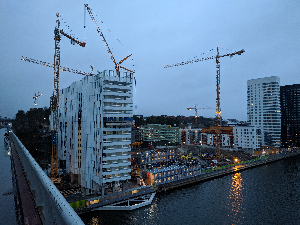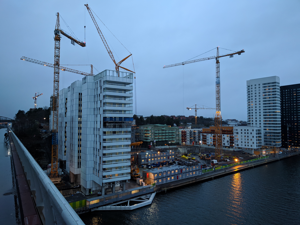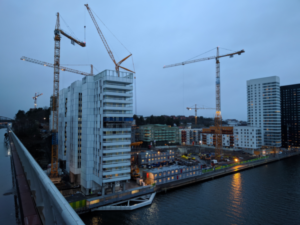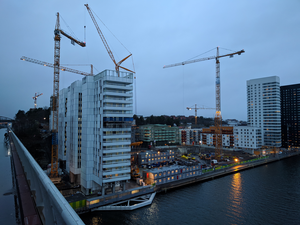,
u: f32,
v: f32,
) -> Option {
if ![u, v].iter().all(|c| (0.0..=1.0).contains(c)) {
return None;
}
let (w, h) = img.dimensions();
if w == 0 || h == 0 {
return None;
}
let ui = w as f32 * u - 0.5;
let vi = h as f32 * v - 0.5;
interpolate_bilinear(
img,
ui.max(0.).min((w - 1) as f32),
vi.max(0.).min((h - 1) as f32),
)
}
/// Sample from an image using coordinates in [0, 1], taking the nearest coordinate.
pub fn sample_nearest(
img: &impl GenericImageView,
u: f32,
v: f32,
) -> Option {
if ![u, v].iter().all(|c| (0.0..=1.0).contains(c)) {
return None;
}
let (w, h) = img.dimensions();
let ui = w as f32 * u - 0.5;
let ui = ui.max(0.).min((w.saturating_sub(1)) as f32);
let vi = h as f32 * v - 0.5;
let vi = vi.max(0.).min((h.saturating_sub(1)) as f32);
interpolate_nearest(img, ui, vi)
}
/// Sample from an image using coordinates in [0, w-1] and [0, h-1], taking the
/// nearest pixel.
///
/// Coordinates outside the image bounds will return `None`, however the
/// behavior for points within half a pixel of the image bounds may change in
/// the future.
pub fn interpolate_nearest(
img: &impl GenericImageView,
x: f32,
y: f32,
) -> Option {
let (w, h) = img.dimensions();
if w == 0 || h == 0 {
return None;
}
if !(0.0..=((w - 1) as f32)).contains(&x) {
return None;
}
if !(0.0..=((h - 1) as f32)).contains(&y) {
return None;
}
Some(img.get_pixel(x.round() as u32, y.round() as u32))
}
/// Linearly sample from an image using coordinates in [0, w-1] and [0, h-1].
pub fn interpolate_bilinear(
img: &impl GenericImageView,
x: f32,
y: f32,
) -> Option {
let (w, h) = img.dimensions();
if w == 0 || h == 0 {
return None;
}
if !(0.0..=((w - 1) as f32)).contains(&x) {
return None;
}
if !(0.0..=((h - 1) as f32)).contains(&y) {
return None;
}
let uf = x.floor();
let vf = y.floor();
let uc = (x + 1.).min((w - 1) as f32);
let vc = (y + 1.).min((h - 1) as f32);
// clamp coords to the range of the image
let coords = [[uf, vf], [uf, vc], [uc, vf], [uc, vc]];
assert!(coords
.iter()
.all(|&[u, v]| { img.in_bounds(u as u32, v as u32) }));
let samples = coords.map(|[u, v]| img.get_pixel(u as u32, v as u32));
assert!(P::CHANNEL_COUNT <= 4);
// convert samples to f32
// currently rgba is the largest one,
// so just store as many items as necessary,
// because there's not a simple way to be generic over all of them.
let [sff, sfc, scf, scc] = samples.map(|s| {
let mut out = [0.; 4];
for (i, c) in s.channels().iter().enumerate() {
out[i] = c.to_f32().unwrap();
}
out
});
// weights
let [ufw, vfw] = [x - uf, y - vf];
let [ucw, vcw] = [1. - ufw, 1. - vfw];
// https://en.wikipedia.org/wiki/Bilinear_interpolation#Weighted_mean
// the distance between pixels is 1 so there is no denominator
let wff = ucw * vcw;
let wfc = ucw * vfw;
let wcf = ufw * vcw;
let wcc = ufw * vfw;
assert!(f32::abs((wff + wfc + wcf + wcc) - 1.) < 1e-3);
// hack to get around not being able to construct a generic Pixel
let mut out = samples[0];
for (i, c) in out.channels_mut().iter_mut().enumerate() {
let v = wff * sff[i] + wfc * sfc[i] + wcf * scf[i] + wcc * scc[i];
// this rounding may introduce quantization errors,
// but cannot do anything about it.
*c = ::from(v.round()).unwrap_or({
if v < 0.0 {
P::Subpixel::DEFAULT_MIN_VALUE
} else {
P::Subpixel::DEFAULT_MAX_VALUE
}
})
}
Some(out)
}
// Sample the columns of the supplied image using the provided filter.
// The width of the image remains unchanged.
// ```new_height``` is the desired height of the new image
// ```filter``` is the filter to use for sampling.
// The return value is not necessarily Rgba, the underlying order of channels in ```image``` is
// preserved.
fn vertical_sample(image: &I, new_height: u32, filter: &mut Filter) -> Rgba32FImage
where
I: GenericImageView,
P: Pixel + 'static,
S: Primitive + 'static,
{
let (width, height) = image.dimensions();
let mut out = ImageBuffer::new(width, new_height);
let mut ws = Vec::new();
let ratio = height as f32 / new_height as f32;
let sratio = if ratio < 1.0 { 1.0 } else { ratio };
let src_support = filter.support * sratio;
for outy in 0..new_height {
// For an explanation of this algorithm, see the comments
// in horizontal_sample.
let inputy = (outy as f32 + 0.5) * ratio;
let left = (inputy - src_support).floor() as i64;
let left = clamp(left, 0, >::from(height) - 1) as u32;
let right = (inputy + src_support).ceil() as i64;
let right = clamp(
right,
>::from(left) + 1,
>::from(height),
) as u32;
let inputy = inputy - 0.5;
ws.clear();
let mut sum = 0.0;
for i in left..right {
let w = (filter.kernel)((i as f32 - inputy) / sratio);
ws.push(w);
sum += w;
}
ws.iter_mut().for_each(|w| *w /= sum);
for x in 0..width {
let mut t = (0.0, 0.0, 0.0, 0.0);
for (i, w) in ws.iter().enumerate() {
let p = image.get_pixel(x, left + i as u32);
#[allow(deprecated)]
let (k1, k2, k3, k4) = p.channels4();
let vec: (f32, f32, f32, f32) = (
NumCast::from(k1).unwrap(),
NumCast::from(k2).unwrap(),
NumCast::from(k3).unwrap(),
NumCast::from(k4).unwrap(),
);
t.0 += vec.0 * w;
t.1 += vec.1 * w;
t.2 += vec.2 * w;
t.3 += vec.3 * w;
}
#[allow(deprecated)]
// This is not necessarily Rgba.
let t = Pixel::from_channels(t.0, t.1, t.2, t.3);
out.put_pixel(x, outy, t);
}
}
out
}
/// Local struct for keeping track of pixel sums for fast thumbnail averaging
struct ThumbnailSum(S::Larger, S::Larger, S::Larger, S::Larger);
impl ThumbnailSum {
fn zeroed() -> Self {
ThumbnailSum(
S::Larger::zero(),
S::Larger::zero(),
S::Larger::zero(),
S::Larger::zero(),
)
}
fn sample_val(val: S) -> S::Larger {
::from(val).unwrap()
}
fn add_pixel>(&mut self, pixel: P) {
#[allow(deprecated)]
let pixel = pixel.channels4();
self.0 += Self::sample_val(pixel.0);
self.1 += Self::sample_val(pixel.1);
self.2 += Self::sample_val(pixel.2);
self.3 += Self::sample_val(pixel.3);
}
}
/// Resize the supplied image to the specific dimensions.
///
/// For downscaling, this method uses a fast integer algorithm where each source pixel contributes
/// to exactly one target pixel. May give aliasing artifacts if new size is close to old size.
///
/// In case the current width is smaller than the new width or similar for the height, another
/// strategy is used instead. For each pixel in the output, a rectangular region of the input is
/// determined, just as previously. But when no input pixel is part of this region, the nearest
/// pixels are interpolated instead.
///
/// For speed reasons, all interpolation is performed linearly over the colour values. It will not
/// take the pixel colour spaces into account.
pub fn thumbnail(image: &I, new_width: u32, new_height: u32) -> ImageBuffer>
where
I: GenericImageView,
P: Pixel + 'static,
S: Primitive + Enlargeable + 'static,
{
let (width, height) = image.dimensions();
let mut out = ImageBuffer::new(new_width, new_height);
let x_ratio = width as f32 / new_width as f32;
let y_ratio = height as f32 / new_height as f32;
for outy in 0..new_height {
let bottomf = outy as f32 * y_ratio;
let topf = bottomf + y_ratio;
let bottom = clamp(bottomf.ceil() as u32, 0, height - 1);
let top = clamp(topf.ceil() as u32, bottom, height);
for outx in 0..new_width {
let leftf = outx as f32 * x_ratio;
let rightf = leftf + x_ratio;
let left = clamp(leftf.ceil() as u32, 0, width - 1);
let right = clamp(rightf.ceil() as u32, left, width);
let avg = if bottom != top && left != right {
thumbnail_sample_block(image, left, right, bottom, top)
} else if bottom != top {
// && left == right
// In the first column we have left == 0 and right > ceil(y_scale) > 0 so this
// assertion can never trigger.
debug_assert!(
left > 0 && right > 0,
"First output column must have corresponding pixels"
);
let fraction_horizontal = (leftf.fract() + rightf.fract()) / 2.;
thumbnail_sample_fraction_horizontal(
image,
right - 1,
fraction_horizontal,
bottom,
top,
)
} else if left != right {
// && bottom == top
// In the first line we have bottom == 0 and top > ceil(x_scale) > 0 so this
// assertion can never trigger.
debug_assert!(
bottom > 0 && top > 0,
"First output row must have corresponding pixels"
);
let fraction_vertical = (topf.fract() + bottomf.fract()) / 2.;
thumbnail_sample_fraction_vertical(image, left, right, top - 1, fraction_vertical)
} else {
// bottom == top && left == right
let fraction_horizontal = (topf.fract() + bottomf.fract()) / 2.;
let fraction_vertical = (leftf.fract() + rightf.fract()) / 2.;
thumbnail_sample_fraction_both(
image,
right - 1,
fraction_horizontal,
top - 1,
fraction_vertical,
)
};
#[allow(deprecated)]
let pixel = Pixel::from_channels(avg.0, avg.1, avg.2, avg.3);
out.put_pixel(outx, outy, pixel);
}
}
out
}
/// Get a pixel for a thumbnail where the input window encloses at least a full pixel.
fn thumbnail_sample_block(
image: &I,
left: u32,
right: u32,
bottom: u32,
top: u32,
) -> (S, S, S, S)
where
I: GenericImageView,
P: Pixel,
S: Primitive + Enlargeable,
{
let mut sum = ThumbnailSum::zeroed();
for y in bottom..top {
for x in left..right {
let k = image.get_pixel(x, y);
sum.add_pixel(k);
}
}
let n = ::from((right - left) * (top - bottom)).unwrap();
let round = ::from(n / NumCast::from(2).unwrap()).unwrap();
(
S::clamp_from((sum.0 + round) / n),
S::clamp_from((sum.1 + round) / n),
S::clamp_from((sum.2 + round) / n),
S::clamp_from((sum.3 + round) / n),
)
}
/// Get a thumbnail pixel where the input window encloses at least a vertical pixel.
fn thumbnail_sample_fraction_horizontal(
image: &I,
left: u32,
fraction_horizontal: f32,
bottom: u32,
top: u32,
) -> (S, S, S, S)
where
I: GenericImageView,
P: Pixel,
S: Primitive + Enlargeable,
{
let fract = fraction_horizontal;
let mut sum_left = ThumbnailSum::zeroed();
let mut sum_right = ThumbnailSum::zeroed();
for x in bottom..top {
let k_left = image.get_pixel(left, x);
sum_left.add_pixel(k_left);
let k_right = image.get_pixel(left + 1, x);
sum_right.add_pixel(k_right);
}
// Now we approximate: left/n*(1-fract) + right/n*fract
let fact_right = fract / ((top - bottom) as f32);
let fact_left = (1. - fract) / ((top - bottom) as f32);
let mix_left_and_right = |leftv: S::Larger, rightv: S::Larger| {
::from(
fact_left * leftv.to_f32().unwrap() + fact_right * rightv.to_f32().unwrap(),
)
.expect("Average sample value should fit into sample type")
};
(
mix_left_and_right(sum_left.0, sum_right.0),
mix_left_and_right(sum_left.1, sum_right.1),
mix_left_and_right(sum_left.2, sum_right.2),
mix_left_and_right(sum_left.3, sum_right.3),
)
}
/// Get a thumbnail pixel where the input window encloses at least a horizontal pixel.
fn thumbnail_sample_fraction_vertical(
image: &I,
left: u32,
right: u32,
bottom: u32,
fraction_vertical: f32,
) -> (S, S, S, S)
where
I: GenericImageView,
P: Pixel,
S: Primitive + Enlargeable,
{
let fract = fraction_vertical;
let mut sum_bot = ThumbnailSum::zeroed();
let mut sum_top = ThumbnailSum::zeroed();
for x in left..right {
let k_bot = image.get_pixel(x, bottom);
sum_bot.add_pixel(k_bot);
let k_top = image.get_pixel(x, bottom + 1);
sum_top.add_pixel(k_top);
}
// Now we approximate: bot/n*fract + top/n*(1-fract)
let fact_top = fract / ((right - left) as f32);
let fact_bot = (1. - fract) / ((right - left) as f32);
let mix_bot_and_top = |botv: S::Larger, topv: S::Larger| {
::from(fact_bot * botv.to_f32().unwrap() + fact_top * topv.to_f32().unwrap())
.expect("Average sample value should fit into sample type")
};
(
mix_bot_and_top(sum_bot.0, sum_top.0),
mix_bot_and_top(sum_bot.1, sum_top.1),
mix_bot_and_top(sum_bot.2, sum_top.2),
mix_bot_and_top(sum_bot.3, sum_top.3),
)
}
/// Get a single pixel for a thumbnail where the input window does not enclose any full pixel.
fn thumbnail_sample_fraction_both(
image: &I,
left: u32,
fraction_vertical: f32,
bottom: u32,
fraction_horizontal: f32,
) -> (S, S, S, S)
where
I: GenericImageView,
P: Pixel,
S: Primitive + Enlargeable,
{
#[allow(deprecated)]
let k_bl = image.get_pixel(left, bottom).channels4();
#[allow(deprecated)]
let k_tl = image.get_pixel(left, bottom + 1).channels4();
#[allow(deprecated)]
let k_br = image.get_pixel(left + 1, bottom).channels4();
#[allow(deprecated)]
let k_tr = image.get_pixel(left + 1, bottom + 1).channels4();
let frac_v = fraction_vertical;
let frac_h = fraction_horizontal;
let fact_tr = frac_v * frac_h;
let fact_tl = frac_v * (1. - frac_h);
let fact_br = (1. - frac_v) * frac_h;
let fact_bl = (1. - frac_v) * (1. - frac_h);
let mix = |br: S, tr: S, bl: S, tl: S| {
::from(
fact_br * br.to_f32().unwrap()
+ fact_tr * tr.to_f32().unwrap()
+ fact_bl * bl.to_f32().unwrap()
+ fact_tl * tl.to_f32().unwrap(),
)
.expect("Average sample value should fit into sample type")
};
(
mix(k_br.0, k_tr.0, k_bl.0, k_tl.0),
mix(k_br.1, k_tr.1, k_bl.1, k_tl.1),
mix(k_br.2, k_tr.2, k_bl.2, k_tl.2),
mix(k_br.3, k_tr.3, k_bl.3, k_tl.3),
)
}
/// Perform a 3x3 box filter on the supplied image.
/// ```kernel``` is an array of the filter weights of length 9.
pub fn filter3x3(image: &I, kernel: &[f32]) -> ImageBuffer>
where
I: GenericImageView,
P: Pixel + 'static,
S: Primitive + 'static,
{
// The kernel's input positions relative to the current pixel.
let taps: &[(isize, isize)] = &[
(-1, -1),
(0, -1),
(1, -1),
(-1, 0),
(0, 0),
(1, 0),
(-1, 1),
(0, 1),
(1, 1),
];
let (width, height) = image.dimensions();
let mut out = ImageBuffer::new(width, height);
let max = S::DEFAULT_MAX_VALUE;
let max: f32 = NumCast::from(max).unwrap();
let sum = match kernel.iter().fold(0.0, |s, &item| s + item) {
x if x == 0.0 => 1.0,
sum => sum,
};
let sum = (sum, sum, sum, sum);
for y in 1..height - 1 {
for x in 1..width - 1 {
let mut t = (0.0, 0.0, 0.0, 0.0);
// TODO: There is no need to recalculate the kernel for each pixel.
// Only a subtract and addition is needed for pixels after the first
// in each row.
for (&k, &(a, b)) in kernel.iter().zip(taps.iter()) {
let k = (k, k, k, k);
let x0 = x as isize + a;
let y0 = y as isize + b;
let p = image.get_pixel(x0 as u32, y0 as u32);
#[allow(deprecated)]
let (k1, k2, k3, k4) = p.channels4();
let vec: (f32, f32, f32, f32) = (
NumCast::from(k1).unwrap(),
NumCast::from(k2).unwrap(),
NumCast::from(k3).unwrap(),
NumCast::from(k4).unwrap(),
);
t.0 += vec.0 * k.0;
t.1 += vec.1 * k.1;
t.2 += vec.2 * k.2;
t.3 += vec.3 * k.3;
}
let (t1, t2, t3, t4) = (t.0 / sum.0, t.1 / sum.1, t.2 / sum.2, t.3 / sum.3);
#[allow(deprecated)]
let t = Pixel::from_channels(
NumCast::from(clamp(t1, 0.0, max)).unwrap(),
NumCast::from(clamp(t2, 0.0, max)).unwrap(),
NumCast::from(clamp(t3, 0.0, max)).unwrap(),
NumCast::from(clamp(t4, 0.0, max)).unwrap(),
);
out.put_pixel(x, y, t);
}
}
out
}
/// Resize the supplied image to the specified dimensions.
/// ```nwidth``` and ```nheight``` are the new dimensions.
/// ```filter``` is the sampling filter to use.
pub fn resize(
image: &I,
nwidth: u32,
nheight: u32,
filter: FilterType,
) -> ImageBuffer::Subpixel>>
where
I::Pixel: 'static,
::Subpixel: 'static,
{
// check if the new dimensions are the same as the old. if they are, make a copy instead of resampling
if (nwidth, nheight) == image.dimensions() {
let mut tmp = ImageBuffer::new(image.width(), image.height());
tmp.copy_from(image, 0, 0).unwrap();
return tmp;
}
let mut method = match filter {
FilterType::Nearest => Filter {
kernel: Box::new(box_kernel),
support: 0.0,
},
FilterType::Triangle => Filter {
kernel: Box::new(triangle_kernel),
support: 1.0,
},
FilterType::CatmullRom => Filter {
kernel: Box::new(catmullrom_kernel),
support: 2.0,
},
FilterType::Gaussian => Filter {
kernel: Box::new(gaussian_kernel),
support: 3.0,
},
FilterType::Lanczos3 => Filter {
kernel: Box::new(lanczos3_kernel),
support: 3.0,
},
};
// Note: tmp is not necessarily actually Rgba
let tmp: Rgba32FImage = vertical_sample(image, nheight, &mut method);
horizontal_sample(&tmp, nwidth, &mut method)
}
/// Performs a Gaussian blur on the supplied image.
/// ```sigma``` is a measure of how much to blur by.
pub fn blur(
image: &I,
sigma: f32,
) -> ImageBuffer::Subpixel>>
where
I::Pixel: 'static,
{
let sigma = if sigma <= 0.0 { 1.0 } else { sigma };
let mut method = Filter {
kernel: Box::new(|x| gaussian(x, sigma)),
support: 2.0 * sigma,
};
let (width, height) = image.dimensions();
// Keep width and height the same for horizontal and
// vertical sampling.
// Note: tmp is not necessarily actually Rgba
let tmp: Rgba32FImage = vertical_sample(image, height, &mut method);
horizontal_sample(&tmp, width, &mut method)
}
/// Performs an unsharpen mask on the supplied image.
/// ```sigma``` is the amount to blur the image by.
/// ```threshold``` is the threshold for minimal brightness change that will be sharpened.
///
/// See
pub fn unsharpen(image: &I, sigma: f32, threshold: i32) -> ImageBuffer>
where
I: GenericImageView,
P: Pixel + 'static,
S: Primitive + 'static,
{
let mut tmp = blur(image, sigma);
let max = S::DEFAULT_MAX_VALUE;
let max: i32 = NumCast::from(max).unwrap();
let (width, height) = image.dimensions();
for y in 0..height {
for x in 0..width {
let a = image.get_pixel(x, y);
let b = tmp.get_pixel_mut(x, y);
let p = a.map2(b, |c, d| {
let ic: i32 = NumCast::from(c).unwrap();
let id: i32 = NumCast::from(d).unwrap();
let diff = (ic - id).abs();
if diff > threshold {
let e = clamp(ic + diff, 0, max); // FIXME what does this do for f32? clamp 0-1 integers??
NumCast::from(e).unwrap()
} else {
c
}
});
*b = p;
}
}
tmp
}
#[cfg(test)]
mod tests {
use super::{resize, sample_bilinear, sample_nearest, FilterType};
use crate::{GenericImageView, ImageBuffer, RgbImage};
#[cfg(feature = "benchmarks")]
use test;
#[bench]
#[cfg(all(feature = "benchmarks", feature = "png"))]
fn bench_resize(b: &mut test::Bencher) {
use std::path::Path;
let img = crate::open(&Path::new("./examples/fractal.png")).unwrap();
b.iter(|| {
test::black_box(resize(&img, 200, 200, FilterType::Nearest));
});
b.bytes = 800 * 800 * 3 + 200 * 200 * 3;
}
#[test]
#[cfg(feature = "png")]
fn test_resize_same_size() {
use std::path::Path;
let img = crate::open(&Path::new("./examples/fractal.png")).unwrap();
let resize = img.resize(img.width(), img.height(), FilterType::Triangle);
assert!(img.pixels().eq(resize.pixels()))
}
#[test]
#[cfg(feature = "png")]
fn test_sample_bilinear() {
use std::path::Path;
let img = crate::open(&Path::new("./examples/fractal.png")).unwrap();
assert!(sample_bilinear(&img, 0., 0.).is_some());
assert!(sample_bilinear(&img, 1., 0.).is_some());
assert!(sample_bilinear(&img, 0., 1.).is_some());
assert!(sample_bilinear(&img, 1., 1.).is_some());
assert!(sample_bilinear(&img, 0.5, 0.5).is_some());
assert!(sample_bilinear(&img, 1.2, 0.5).is_none());
assert!(sample_bilinear(&img, 0.5, 1.2).is_none());
assert!(sample_bilinear(&img, 1.2, 1.2).is_none());
assert!(sample_bilinear(&img, -0.1, 0.2).is_none());
assert!(sample_bilinear(&img, 0.2, -0.1).is_none());
assert!(sample_bilinear(&img, -0.1, -0.1).is_none());
}
#[test]
#[cfg(feature = "png")]
fn test_sample_nearest() {
use std::path::Path;
let img = crate::open(&Path::new("./examples/fractal.png")).unwrap();
assert!(sample_nearest(&img, 0., 0.).is_some());
assert!(sample_nearest(&img, 1., 0.).is_some());
assert!(sample_nearest(&img, 0., 1.).is_some());
assert!(sample_nearest(&img, 1., 1.).is_some());
assert!(sample_nearest(&img, 0.5, 0.5).is_some());
assert!(sample_nearest(&img, 1.2, 0.5).is_none());
assert!(sample_nearest(&img, 0.5, 1.2).is_none());
assert!(sample_nearest(&img, 1.2, 1.2).is_none());
assert!(sample_nearest(&img, -0.1, 0.2).is_none());
assert!(sample_nearest(&img, 0.2, -0.1).is_none());
assert!(sample_nearest(&img, -0.1, -0.1).is_none());
}
#[test]
fn test_sample_bilinear_correctness() {
use crate::Rgba;
let img = ImageBuffer::from_fn(2, 2, |x, y| match (x, y) {
(0, 0) => Rgba([255, 0, 0, 0]),
(0, 1) => Rgba([0, 255, 0, 0]),
(1, 0) => Rgba([0, 0, 255, 0]),
(1, 1) => Rgba([0, 0, 0, 255]),
_ => panic!(),
});
assert_eq!(sample_bilinear(&img, 0.5, 0.5), Some(Rgba([64; 4])));
assert_eq!(sample_bilinear(&img, 0.0, 0.0), Some(Rgba([255, 0, 0, 0])));
assert_eq!(sample_bilinear(&img, 0.0, 1.0), Some(Rgba([0, 255, 0, 0])));
assert_eq!(sample_bilinear(&img, 1.0, 0.0), Some(Rgba([0, 0, 255, 0])));
assert_eq!(sample_bilinear(&img, 1.0, 1.0), Some(Rgba([0, 0, 0, 255])));
assert_eq!(
sample_bilinear(&img, 0.5, 0.0),
Some(Rgba([128, 0, 128, 0]))
);
assert_eq!(
sample_bilinear(&img, 0.0, 0.5),
Some(Rgba([128, 128, 0, 0]))
);
assert_eq!(
sample_bilinear(&img, 0.5, 1.0),
Some(Rgba([0, 128, 0, 128]))
);
assert_eq!(
sample_bilinear(&img, 1.0, 0.5),
Some(Rgba([0, 0, 128, 128]))
);
}
#[test]
fn test_sample_nearest_correctness() {
use crate::Rgba;
let img = ImageBuffer::from_fn(2, 2, |x, y| match (x, y) {
(0, 0) => Rgba([255, 0, 0, 0]),
(0, 1) => Rgba([0, 255, 0, 0]),
(1, 0) => Rgba([0, 0, 255, 0]),
(1, 1) => Rgba([0, 0, 0, 255]),
_ => panic!(),
});
assert_eq!(sample_nearest(&img, 0.0, 0.0), Some(Rgba([255, 0, 0, 0])));
assert_eq!(sample_nearest(&img, 0.0, 1.0), Some(Rgba([0, 255, 0, 0])));
assert_eq!(sample_nearest(&img, 1.0, 0.0), Some(Rgba([0, 0, 255, 0])));
assert_eq!(sample_nearest(&img, 1.0, 1.0), Some(Rgba([0, 0, 0, 255])));
assert_eq!(sample_nearest(&img, 0.5, 0.5), Some(Rgba([0, 0, 0, 255])));
assert_eq!(sample_nearest(&img, 0.5, 0.0), Some(Rgba([0, 0, 255, 0])));
assert_eq!(sample_nearest(&img, 0.0, 0.5), Some(Rgba([0, 255, 0, 0])));
assert_eq!(sample_nearest(&img, 0.5, 1.0), Some(Rgba([0, 0, 0, 255])));
assert_eq!(sample_nearest(&img, 1.0, 0.5), Some(Rgba([0, 0, 0, 255])));
}
#[bench]
#[cfg(all(feature = "benchmarks", feature = "tiff"))]
fn bench_resize_same_size(b: &mut test::Bencher) {
let path = concat!(
env!("CARGO_MANIFEST_DIR"),
"/tests/images/tiff/testsuite/mandrill.tiff"
);
let image = crate::open(path).unwrap();
b.iter(|| {
test::black_box(image.resize(image.width(), image.height(), FilterType::CatmullRom));
});
b.bytes = (image.width() * image.height() * 3) as u64;
}
#[test]
fn test_issue_186() {
let img: RgbImage = ImageBuffer::new(100, 100);
let _ = resize(&img, 50, 50, FilterType::Lanczos3);
}
#[bench]
#[cfg(all(feature = "benchmarks", feature = "tiff"))]
fn bench_thumbnail(b: &mut test::Bencher) {
let path = concat!(
env!("CARGO_MANIFEST_DIR"),
"/tests/images/tiff/testsuite/mandrill.tiff"
);
let image = crate::open(path).unwrap();
b.iter(|| {
test::black_box(image.thumbnail(256, 256));
});
b.bytes = 512 * 512 * 4 + 256 * 256 * 4;
}
#[bench]
#[cfg(all(feature = "benchmarks", feature = "tiff"))]
fn bench_thumbnail_upsize(b: &mut test::Bencher) {
let path = concat!(
env!("CARGO_MANIFEST_DIR"),
"/tests/images/tiff/testsuite/mandrill.tiff"
);
let image = crate::open(path).unwrap().thumbnail(256, 256);
b.iter(|| {
test::black_box(image.thumbnail(512, 512));
});
b.bytes = 512 * 512 * 4 + 256 * 256 * 4;
}
#[bench]
#[cfg(all(feature = "benchmarks", feature = "tiff"))]
fn bench_thumbnail_upsize_irregular(b: &mut test::Bencher) {
let path = concat!(
env!("CARGO_MANIFEST_DIR"),
"/tests/images/tiff/testsuite/mandrill.tiff"
);
let image = crate::open(path).unwrap().thumbnail(193, 193);
b.iter(|| {
test::black_box(image.thumbnail(256, 256));
});
b.bytes = 193 * 193 * 4 + 256 * 256 * 4;
}
#[test]
#[cfg(feature = "png")]
fn resize_transparent_image() {
use super::FilterType::{CatmullRom, Gaussian, Lanczos3, Nearest, Triangle};
use crate::imageops::crop_imm;
use crate::RgbaImage;
fn assert_resize(image: &RgbaImage, filter: FilterType) {
let resized = resize(image, 16, 16, filter);
let cropped = crop_imm(&resized, 5, 5, 6, 6).to_image();
for pixel in cropped.pixels() {
let alpha = pixel.0[3];
assert!(
alpha != 254 && alpha != 253,
"alpha value: {}, {:?}",
alpha,
filter
);
}
}
let path = concat!(
env!("CARGO_MANIFEST_DIR"),
"/tests/images/png/transparency/tp1n3p08.png"
);
let img = crate::open(path).unwrap();
let rgba8 = img.as_rgba8().unwrap();
let filters = &[Nearest, Triangle, CatmullRom, Gaussian, Lanczos3];
for filter in filters {
assert_resize(rgba8, *filter);
}
}
#[test]
fn bug_1600() {
let image = crate::RgbaImage::from_raw(629, 627, vec![255; 629 * 627 * 4]).unwrap();
let result = resize(&image, 22, 22, FilterType::Lanczos3);
assert!(result.into_raw().into_iter().any(|c| c != 0));
}
}









